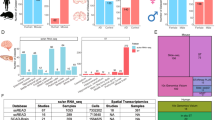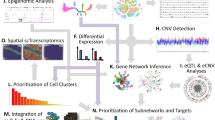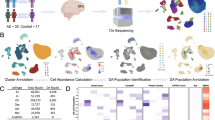Abstract
Alzheimer's disease is a complex and devastating neurological disorder, and there is a pressing need to discover effective treatments. Analyses in specific brain regions can provide valuable insights into the underlying pathology of the disease. Molecular biology techniques, such as single-cell analysis, can offer an in-depth analysis of cellular-level changes in the brain in Alzheimer's disease. However, integrating single-cell RNA sequencing (scRNA-seq) data from different studies can be challenging due to batch effects, which can lead to spurious results. The dominant approach for addressing this issue is SCALEX, an online single-cell data integration method that projects heterogeneous datasets into a common cell-embedding space. In this paper, we highlight the impact of SCALEX in detecting accurate biomarkers in the context of significant genes that are leading scRNA-seq data. We demonstrate the pitfalls of traditional data integration methods and show the protection offered by SCALEX in preserving the biological heterogeneity of the sample while minimizing the impact of technical artifacts introduced by batch effects. Our results show that integrating scRNA-seq data with SCALEX can lead to more accurate biomarkers and significant genes, offering insights into the underlying pathology of Alzheimer's disease. These findings have important implications for the development of new therapies and treatments for this devastating disease.
Access this chapter
Tax calculation will be finalised at checkout
Purchases are for personal use only
Similar content being viewed by others
References
Jiang, J., Cankun, W., Ren, Q., Hongjun, F., Qin, M.: ScREAD: a single-cell RNA-Seq database for alzheimer’s disease. IScience 23(11), 101769 (20 Nov 2020)
Chen, T., Guestrin, C.: XGBoost: a scalable tree boosting system. In: Proceedings of the 22nd ACM SIGKDD International Conference on Knowedge Discovery and Data Mining (KDD ‘16). Association for Computing Machinery, New York,pp. 785–794 (2016). https://doi.org/10.1145/2939672.2939785
Lazaros, K., Tasoulis, S., Vrahatis, A., Plagianakos, V.: Feature selection for high dimensional data using supervised machine learning techniques. In: 2022 IEEE International Conference on Big Data (Big Data), Osaka, Japan, pp. 3891–3894 (2022). https://doi.org/10.1109/BigData55660.2022.10020654
Mathys, H., Davila-Velderrain, J., Peng, Z., et al.: Single-cell transcriptomic analysis of Alzheimer’s disease. Nature 570, 332–337 (2019). https://doi.org/10.1038/s41586-019-1195-2
Paplomatas, P., Krokidis, M.G., Vlamos, P., Vrahatis, A.G.: An ensemble feature selection approach for analysis and modeling of transcriptome data in alzheimer’s disease. Appl. Sci. 13, 2353 (2023). https://doi.org/10.3390/app13042353
Polański, K., Young, M.D., Miao, Z., Meyer, K.B.,Teichmann, S.A., Park, J.-E.: BBKNN: fast batch alignment of single cell transcriptomes. Bioinformatics 36(3), 964–965 February (2020). https://doi.org/10.1093/bioinformatics/btz625
Korsunsky, I., Millard, N., Fan, J., et al.: Fast, sensitive and accurate integration of single-cell data with Harmony. Nat. Methods 16, 1289–1296 (2019). https://doi.org/10.1038/s41592-019-0619-0
Hie, B., Bryson, B., Berger, B.: Efficient integration of heterogeneous single-cell transcriptomes using Scanorama. Nat. Biotechnol. 37, 685–691 (2019). https://doi.org/10.1038/s41587-019-0113-3
Butler, A., Hoffman, P., Smibert, P., Papalexi, E., Satija, R.: Integrating single-cell transcriptomic data across different conditions, technologies, and species. Nat. Biotechnol. 36(5), 411–420 (2018). https://doi.org/10.1038/nbt.4096. Epub 2018 Apr 2. PMID: 29608179; PMCID: PMC6700744
Barkas, N., et al.: Joint analysis of heterogeneous single-cell RNA-seq dataset collections. Nat. Methods (2019). https://doi.org/10.1038/s41592-019-0466-z
Wolf, F., Angerer, P., Theis, F.: SCANPY: large-scale single-cell gene expression data analysis. Genome Biol. 19, 15 (2018). https://doi.org/10.1186/s13059-017-1382-0
Lopez, R., Regier, J., Cole, M.B., et al.: Deep generative modeling for single-cell transcriptomics. Nat. Methods 15, 1053–1058 (2018). https://doi.org/10.1038/s41592-018-0229-2
Xiong, L., Tian, K., Li, Y., et al.: Online single-cell data integration through projecting heterogeneous datasets into a common cell-embedding space. Nat. Commun. 13, 6118 (2022). https://doi.org/10.1038/s41467-022-33758-z
Argelaguet, R., Cuomo, A.S.E., Stegle, O., et al.: Computational principles and challenges in single-cell data integration. Nat. Biotechnol. 39, 1202–1215 (2021). https://doi.org/10.1038/s41587-021-00895-7
Luecken, M.D., Büttner, M., Chaichoompu, K., et al.: Benchmarking atlas-level data integration in single-cell genomics. Nat. Methods 19, 41–50 (2022). https://doi.org/10.1038/s41592-021-01336-8
Kolodziejczyk, A.A., Kim, J.K., Svensson, V., Marioni, J.C., Teichmann, S.A.: The technology and biology of single-cell RNA sequencing. Mol. Cell 58, 610–620 (2015)
McInnes et al.: UMAP: uniform manifold approximation and projection. J. Open Source Softw. 3(29), 861 (2018). https://doi.org/10.21105/joss.00861
Rautenstrauch, P., Vlot, A.H.C., Saran, S., Ohler, U.: Intricacies of single-cell multi-omics data integration. Trends Genet. 38(2), 128–139 (2022). https://doi.org/10.1016/j.tig.2021.08.012
Wang, M., Song, Wm., Ming, C., et al.: Guidelines for bioinformatics of single-cell sequencing data analysis in Alzheimer’s disease: review, recommendation, implementation and application. Mol. Neurodegeneration 17, 17 (2022). https://doi.org/10.1186/s13024-022-00517-z
Chen, G., Ning, B., Shi, T.: Single-cell RNA-seq technologies and related computational data analysis. Front. Genet. 10, 317 (2019). https://doi.org/10.3389/fgene.2019.00317
Acknowledgment
This research is funded by the European Union and Greece (Partnership Agreement for the Development Framework 2014–2020) under the Regional Operational Programme Ionian Islands 2014–2020, project title: “Study of Clinical trial protocols with biomarkers that define the evolution of non-genetic neurodegenerative diseases- NEUROTRIAL”, project number: 5016089.
Author information
Authors and Affiliations
Corresponding author
Editor information
Editors and Affiliations
Rights and permissions
Copyright information
© 2023 IFIP International Federation for Information Processing
About this paper
Cite this paper
Vrahatis, A.G., Lazaros, K., Paplomatas, P., Krokidis, M.G., Exarchos, T., Vlamos, P. (2023). Applying SCALEX scRNA-Seq Data Integration for Precise Alzheimer’s Disease Biomarker Discovery. In: Maglogiannis, I., Iliadis, L., Papaleonidas, A., Chochliouros, I. (eds) Artificial Intelligence Applications and Innovations. AIAI 2023 IFIP WG 12.5 International Workshops. AIAI 2023. IFIP Advances in Information and Communication Technology, vol 677. Springer, Cham. https://doi.org/10.1007/978-3-031-34171-7_23
Download citation
DOI: https://doi.org/10.1007/978-3-031-34171-7_23
Published:
Publisher Name: Springer, Cham
Print ISBN: 978-3-031-34170-0
Online ISBN: 978-3-031-34171-7
eBook Packages: Computer ScienceComputer Science (R0)





